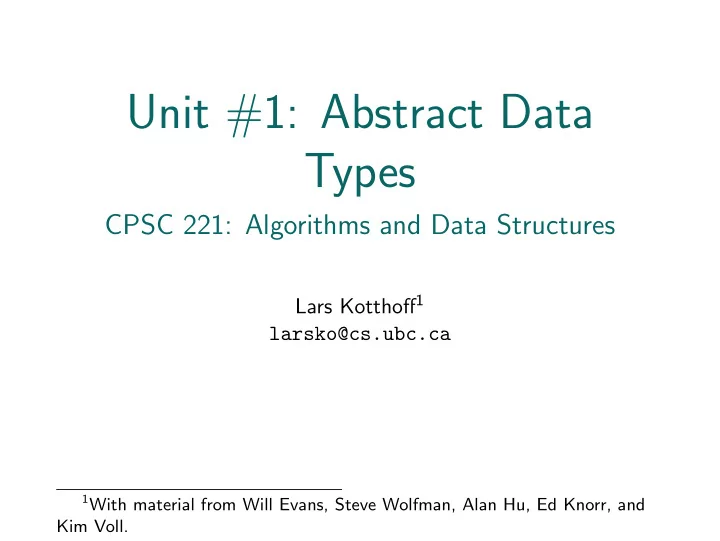

Unit #1: Abstract Data Types CPSC 221: Algorithms and Data Structures Lars Kotthoff 1 larsko@cs.ubc.ca 1 With material from Will Evans, Steve Wolfman, Alan Hu, Ed Knorr, and Kim Voll.
Abstract Data Type formally mathematical description of an object and the set of operations on the object in practice interface of a data structure without implementation
Example: Dictionary ADT ▷ stores pairs of strings: (word, definition) ▷ operations: ▷ insert(word,definition) ▷ delete(word) ▷ find(word) � definition
Another Example: Array ADT ▷ store things like integers, (pointers to) strings, etc. ▷ operations: ▷ initialize an empty array that can hold n things thing A[n]; ▷ access (read or write) the i th thing in the array ( 0 ≤ i ≤ n − 1 ) thing1 = A[i]; Read A[i] = thing2; Write
Why Arrays? ▷ computer memory is an array ▷ read: CPU provides address i , memory unit returns the data stored at i Memory Read 0 0x0..0 128 0x0..1 32 0x0..2 Address 16 0x0..3 3 0x0..4 0x0..7 1 0x0..5 CPU 4 0x0..6 Data 42 0x0..7 5 0x0..8 42 9 0x0..9 2 0x0..A 6 0x0..B . . .
Why Arrays? ▷ computer memory is an array ▷ write: CPU provides address i and data d , memory unit stores data d at i Memory Write 0 0x0..0 128 0x0..1 32 0x0..2 Address 16 0x0..3 3 0x0..4 0x0..7 1 0x0..5 CPU 4 0x0..6 Data 1 0x0..7 5 0x0..8 1 9 0x0..9 2 0x0..A 6 0x0..B . . .
Why Arrays? Computer memory is an array. Every bit has a physical location. http://zeptobars.ru/en/read/how-to-open-microchip-asic-what-inside licensed under Creative Commons Attribution 3.0 Unported.
Why Arrays? ▷ computer memory is an array ▷ simple and fast ▷ used in almost every program ▷ used to implement other data structures
Array limitations ▷ need to know size when array is created Fix: resizeable arrays If the array fills up, allocate a new, bigger array and copy the old contents to the new array. ▷ Indices are integers 0,1,2,. . . Fix: hashing (more later)
How would you implement the Array ADT? Arrays in C++ Create: int A[100]; Access: for(int i=0; i<100; i++) A[i] = (i+1) * A[i-1];
How would you implement the Array ADT? Arrays in C++ Create: int A[100]; Access: for(int i=0; i<100; i++) A[i] = (i+1) * A[i-1]; Warning No bounds checking!
Data Structures as Algorithms Algorithm a high level, language independent description of a step-by-step process for solving a problem Data Structure a way of storing and organizing data so that it can be manipulated as described by an ADT A data structure is defined by the algorithms that implement the ADT operations.
Why so many data structures? Data structures for Dictionary ADT Ideal data structure ▷ List fast, elegant, memory efficient ▷ Skip list Trade-offs ▷ Binary search tree ▷ time vs. space ▷ AVL tree ▷ performance vs. elegance ▷ Splay tree ▷ generality vs. simplicity ▷ B-tree ▷ one operation’s performance vs. ▷ Red-Black tree another’s ▷ Hash table . . .
Code Implementation Theory ▷ abstract base class (interface) describes ADT ▷ concrete classes implement data structures for the ADT ▷ data structures can change without affecting client code Practice ▷ different implementations sometimes suggest different interfaces (generality vs. simplicity) ▷ performance of a data structure may influence the form of the client code (time vs. space, one operation vs. another)
ADT Presentation Algorithm 1. present an ADT 2. motivate with some applications 3. repeat 3.1 develop a data structure for the ADT 3.2 analyze its properties ▷ efficiency ▷ correctness ▷ limitations ▷ ease of programming 4. contrast data structure’s strengths and weaknesses ▷ understand when to use each one
Queue ADT Queue operations ▷ create ▷ destroy enqueue dequeue G F E D C B A ▷ enqueue ▷ dequeue ▷ is empty Queue property If x is enqueued before y is enqueued, then x will be dequeued before y is dequeued. FIFO: First In First Out
Applications of the Queue ▷ hold jobs for a printer ▷ store packets on network routers ▷ hold memory “freelists” ▷ make waitlists fair ▷ breadth first search
Abstract Queue Example enqueue R In order, what letters are dequeued? enqueue O a. OATE dequeue b. ROTA enqueue T enqueue A c. OTAE enqueue T d. None of these, but it can be dequeue determined from just the ADT. dequeue e. None of these, and it cannot be enqueue E determined from just the ADT. dequeue
Circular Array Queue Data Structure Q size − 1 0 7 12 a b c d e front = 7 back = 12 void enqueue(Object x) { Object dequeue() { Q[back] = x; x = Q[front]; back = (back + 1) % size; front = (front + 1) % size; } return x; } bool is_empty() { return (front == back); bool is_full() { } return (front == (back + 1) % size); }
Circular Array Queue Example Size = 4 enqueue R What are the final contents of the array enqueue O queue? dequeue enqueue T a. RTE enqueue A b. RTET enqueue T c. TETA dequeue d. TE dequeue enqueue E e. None dequeue
Linked List Queue Data Structure c e b ∅ b d front back void enqueue(Object x) { Object dequeue() { if (is_empty()) assert(!is_empty()); front = back = new Node(x); Object ret = front->data; else { Node *temp = front; back->next = new Node(x); front = front->next; back = back->next; delete temp; } return ret; } } DIY memory management bool is_empty() { return (front == NULL); }
Circular Array vs. Linked List ▷ ease of implementation ▷ generality ▷ speed ▷ memory use
Recommend
More recommend